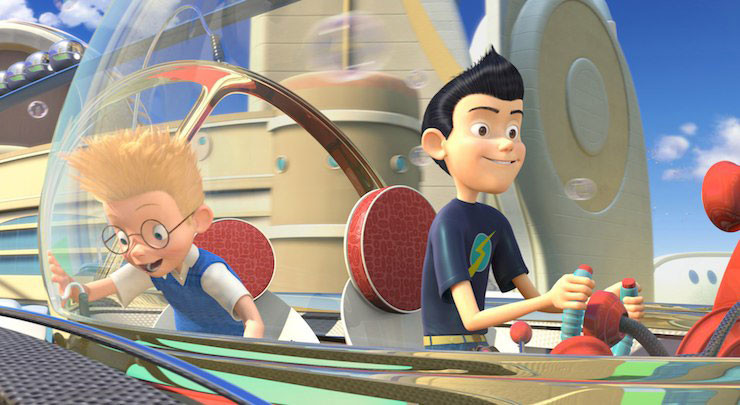“It’s been a long hard day full of emotional turmoil and dinosaur fights.”
For their next foray into computer animation, Disney decided to back away from trying to create something similar in tone to Shrek, and instead, recapture some of the sweetness at least associated with many Disney films, along with the occasional zaniness and attention to detail that was a highlight of the Pixar films.
The result was somewhat of a mess.
For this project, Disney chose to adapt A Day with Wilbur Robinson, a picture book by William Joyce aimed at very young children. The story—I use the word “story” in the loosest sense of the world—is simple indeed: the narrator goes to the house of his friend, Wilbur Robinson, and ends up joining the friend in a search for his grandfather’s teeth, meeting pretty much all of Wilbur’s relatives along the way. SPOILER ALERT: Yes, they find the teeth. YOU CAN ALL RELAX NOW.
Joyce sneaks in a small reference to Duke Ellington and Louis Armstrong, presumably to keep adults awake, but that’s about it for the story and the prose. The point of the book, however, is the illustrations. These are delightful, in particular a page devoted to a frog band—featuring the aforementioned Duke Ellington and Louis Armstrong—with a happy little frog pounding away at the piano and the rest of the frogs playing to keep up. The frogs, I’m happy to say, continue to appear in most of the rest of the book. Other pages feature delightfully strange people, a fun bit where everyone floats in the air, and, of course, a pillow fight. I can’t call it literary, exactly, but I think three and four year olds might like it, especially since Joyce gives them several small things to look for and point at, and it’s also appropriate for slightly older early readers. And for anyone who likes frogs or pictures of frogs.
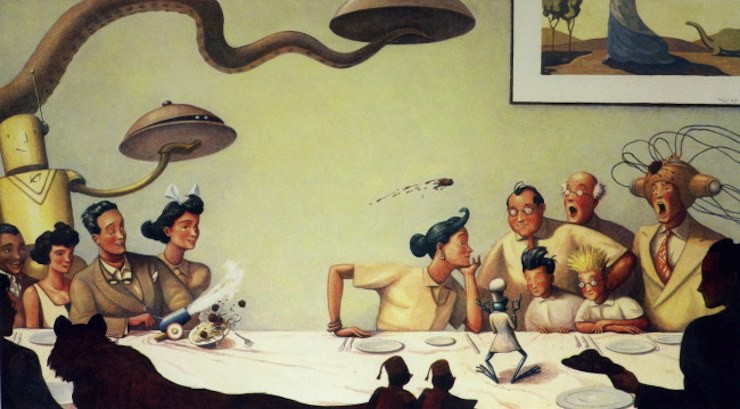
The illustrations were enough to give Disney a visual concept for the film, at least, and pretty much all of the characters make at least one appearance in the film, even if, in a few cases, this is no more than a cameo. “Find teeth,” however, was not exactly the sort of suspenseful, emotional plot that Disney animators were looking for. A subplot, maybe, but not more than that. And so, they came up with “time travel,” which if slightly overused, was at least not something that Disney had tackled before—and was a lot more interesting than teeth.
Plot in hand, animators began working in the film in June 2004. By January 2006, they had enough finished film to show John Lasseter, just appointed the Chief Creative Officer of Walt Disney Animation Studios thanks to Disney’s recent purchase of Pixar. Lasseter didn’t mind the time travel concept, but he did mind the villain, who, in Lasseter’s opinion, wasn’t scary enough. I believe this, since even after tweaking, the villain—Bowler Hat Guy—is not particularly scary. Possibly because he’s voiced by the director (yes, really) or possibly because he’s called, in script, Bowler Hat Guy, which is not exactly the most terrifying villain name ever. Especially given that Bowler Hat Guy entered a long line of films featuring villains with nicely evil names like Cruella, or, for emphasis, Cruella de Vil. Granted, the name Cruella de Vil is incredibly hard to match, much less top, but Bowler Hat Guy? For an evil villain, you aren’t even trying.
Apart from that, Bowler Hat Guy is not, to put it mildly, the world’s most, how shall I say this, competent villain. After all, initially, he’s villaining solely because, unable to come up with his own inventions, he’s decided to steal one from a little kid—an invention that (a) might not even work, and (b) he—Bowler Hat Guy, that is—doesn’t know how to turn it on. And while I can fully sympathize with the inability to come up with Cool Looking Techy Things, and corporate thieves might sympathize with the idea of stealing something you can’t use, in practice, all this does is convince me that this particular villain is (a) pathetic and (b) not going to be harming anyone. So why, exactly, are we worried about him?
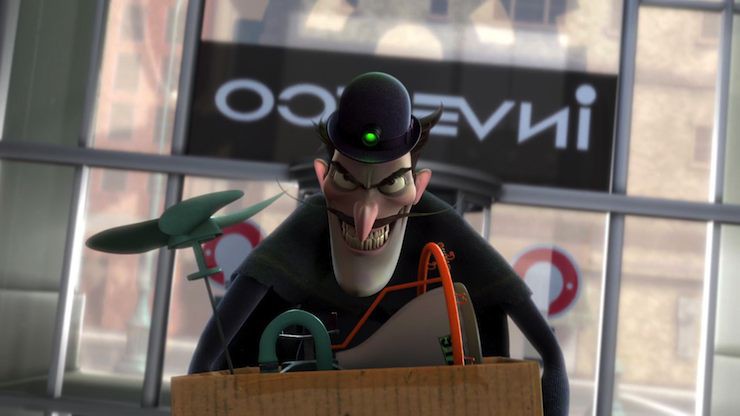
Well, because he can—using yet another stolen invention—convince a singing frog to become his sidekick, which leads to this:
“Ok. Talking frog. Not a good minion.”
And because he can—using a third stolen invention—release a dinosaur on his enemies.
Ok, that one is pretty cool, not least because it leads to a pretty good T-Rex joke, but seriously, until the dinosaur shows up, this is the least threatening villain in any Disney film, ever. For that matter, even after the dinosaur shows up, Bowler Hat Guy is still the least threatening villain in any Disney film, ever.
Even after this was pointed out to him, director Stephen Anderson was apparently still reluctant to make the villain scary, although he did add the dinosaur. (That’s right: in the original version, the villain’s only minion was a talking frog, and that’s even less scary than I just made it sound.) Instead, the main villain became—I hate typing this—a sentient, evil, hat.
The hat is named Doris, and it flies around, and it has some great moments as it attempts to make Bowler Hat Guy just a little more competent, but. It’s an evil hat.
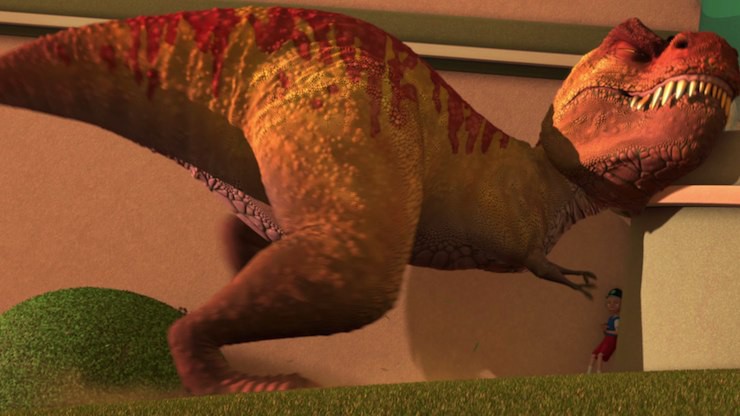
Villains were not the only problem. After Lasseter’s criticisms, a solid 60% of the film was redone, and although I don’t know quite what was changed afterwards, except for the evil hat and the dinosaur, I can say that the final result is a very unevenly paced film that also varies wildly in tone. Portions—especially Wilbur’s introduction to the Robinson family, which surprisingly enough doesn’t happen until about 45 minutes into the film—are wild and zany and filled with various visual jokes, and portions—especially the first 30 minutes of the film—are poignant and touching and all about being alone and without a family and how no one will ever accept you. This leads to several tonally jarring moments, especially in the last parts of the film, where the poignant and touching moments want to interact with the zany moments and just. can’t., and that’s before I mention the segments with the evil, world dominating hats.
What’s frustrating here is that Meet the Robinsons has elements of two really good movies: the touching story of a misfit orphan kid who finds a happy home with a group of equally misfit inventors who love him for being different, and the story of an evil hat bent on world conquest. The first never really gets developed. The second, in the right hands, could easily have become an awesomely bizarre film, but instead, the evil hat is stuck flying around in this film, and it’s outdone by some singing frogs and a dinosaur.
And that’s before getting into the various plot holes that are perhaps inevitable in any time travel film, but stand out here: the only reason, after all, that Lewis gets to travel to the future is because Bowler Hat Guy returned to the past to steal his invention, a trip that leads him to realize that he needs to change Bowler Hat Guy’s past, which he does, transforming Bowler Hat Guy’s life forever and keeping him from becoming an evil villain with an evil hat and occasional dinosaur, which in turn means—I think you’re seeing where I’m going with this, but then again, time travel.
It’s not without its moments. It’s awkwardly paced, yes, but the bizarre characters look fun, a few of the jokes—including a bit about Tom Selleck, who also voices a character in this film—are good, and if the ending is sappy even by Disney standards, well, it’s a feel good sort of ending. And the film’s general message, that everyone, including kids, can learn from failure, and that it’s perfectly ok to fail every once in awhile or even all the time, might be a little ham-handed and over the top in how it’s handled, but it’s also rather reassuring.
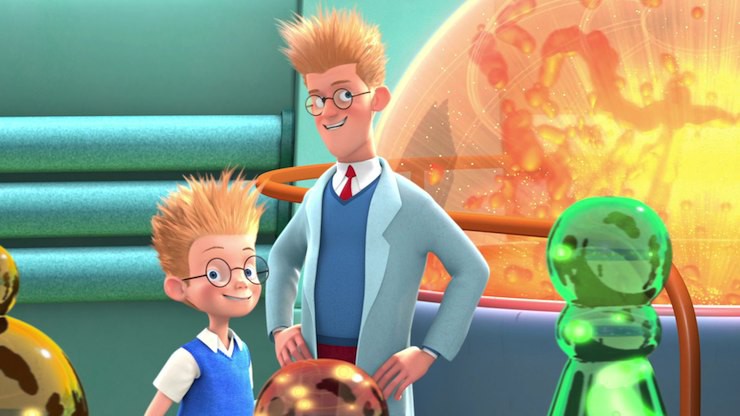
Meet the Robinsons broke even, but was still considered a box office underperformer. John Lasseter cancelled plans for the sequel, along with plans for several other sequels, including, fortunately, a sequel for Chicken Little. The usual merchandise was released, but apparently didn’t sell well (it’s pretty much vanished from the theme parks since) but although the video games can still be found if you search hard enough, the rest of it cannot. Eight years later the film was already mostly forgotten.
Lasseter wasn’t overly concerned. He already had his focus on Princesses.
Time to skip another film, Bolt, which is a Disney original. The first Disney animated film made mostly under Lasseter’s supervision, Bolt was forced through on a rushed production schedule, but despite this, did relatively well both with critics and at the box office, and was later seen as one of the starting points for Disney Renaissance Number Two.
The second starting point was The Princess and the Frog. “The Frog Prince,” coming next week.
Mari Ness lives in central Florida.










